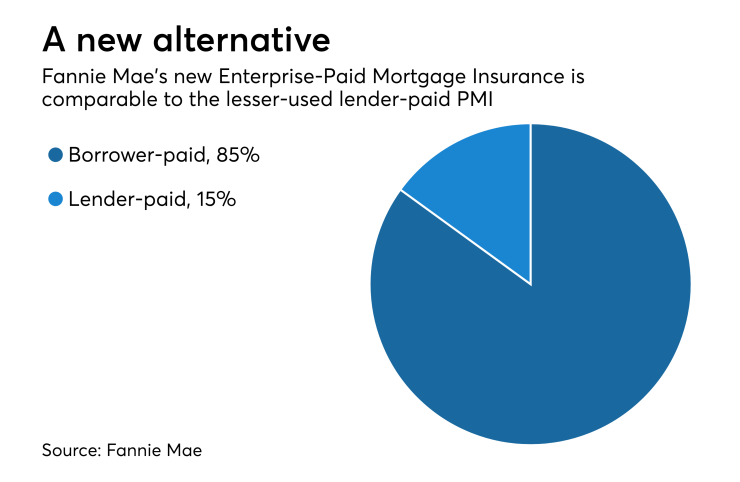A Fannie Mae test to handle the private mortgage insurance process for lenders may raise concerns about charter creep, but the effort reflects its mandate to explore new credit-risk transfer alternatives.
Under the new front-end risk-sharing program, dubbed "Enterprise-Paid Mortgage Insurance," Fannie Mae will obtain and pay the premiums on private mortgage insurance policies on low down payment mortgages — though borrowers ultimately shoulder the cost through a loan-level price adjustment to their interest rates.
EPMI shares a number of features with a Freddie Mac initiative earlier this year called
But critics accused Freddie Mac of
But the PMI alternative is fair game for the government-sponsored enterprises because their conservator, the Federal Housing Finance Agency, has instructed them to develop a variety of credit-risk transfer structures, said Rob Schaefer, Fannie Mae vice president for credit enhancement strategy and management.
"FHFA has wanted us to explore different risk transfer structures, moving risk away from Fannie Mae and away from taxpayers. This is a continuation of that," Schaefer said in an exclusive interview with NMN.
Both EPMI and IMAGIN are comparable to lender-paid mortgage insurance. For some lenders, the cost of EPMI will be an improvement over what they pay for LPMI, Schaefer said. But since LPMI is often offered on a negotiated price, other lenders won't get better pricing with EPMI. Between 10% and 15% of the low down payment mortgages delivered to Fannie Mae use LPMI.

"No. 1, this is an option for lenders," he said. "So we're not going to force any lender to ever use this. If they see this has value, they will consider it. If they don't, no one is going to force them to use this."
Additionally, the loan is only underwritten once; it does not need to go through a separate process to be approved for PMI. Any claims are handed by Fannie Mae.
"We're trying to develop options for lenders to simplify their processes," Schaefer continued. "Both of those are really behind our roll-out of the EPMI pilot."
EPMI also shares similarities with another Fannie risk-sharing product, called
"We have done forward structures with CIRT that are really just like this, where we're getting a 12-month forward commitment from the insurers or MIs," Schaefer said.
During the pilot phase, Fannie Mae is limiting EPMI to whole loan commitments. Those whole loans will be pooled later into MBS and will also be covered by Fannie Mae's credit risk transfer programs. In the future, it could expand the options to include loans delivered in mortgage-backed security commitments.
Fannie Mae collaborated with lenders and private mortgage insurers to develop the structure of EPMI. While private mortgage insurers are not providing the primary coverage on the first EPMI-eligible loans, affiliates of several PMI carriers are participating in the reinsurance panel that provides credit-risk transfer coverage. But Fannie Mae may obtain the primary coverage from approved PMI carriers in future deals, Schaefer said.
The mortgage insurance policy will be paid for through a loan-level price adjustment. "We structured it as an LLPA as opposed to a change in the guarantee fee to make it easier for lenders," Schaefer said, explaining that some sellers might find it more challenging to have loans with different base g-fees together in the same delivery.
But Fannie Mae will look at this over time and if it finds that it is feasible to handle the payment in a different way, it would consider that as well.
The lenders participating in the pilot reflect a variety of company types and sizes. Fannie Mae did not disclose the participants, but as loans are acquired and the coverage obtained, the lenders' names will be released in the information about the transaction.
"Small, medium or large, some lenders will like it, some won't," adding some lenders may prefer to not have to handle the operations and administrative requirements associated with obtaining and maintaining PMI policies, Schaefer said. On the other hand, there are lenders of all sizes that are comfortable with the current process.
"I know there's been a lot of concern about this structure and I want to reiterate this is an option for lenders, they will decide whether this has value. This is not meant to force anybody to do this sort of structure or to undermine the MI industry as we know it," he said.
"We consider the MIs our partners, the MIs have been partners for us for decades and they'll continue to be partners with us going forward. Many lenders will continue to like the way they buy MI now and that's just fine."





